Time-Driven Activity-Based Costing Analysis for BHP Billiton
VerifiedAdded on 2020/05/16
|12
|2861
|72
Report
AI Summary
This report provides an executive summary and detailed analysis of Time-Driven Activity-Based Costing (TDABC), focusing on its implementation within BHP Billiton. The study begins with an introduction to the importance of cost control in managerial accounting, highlighting the limitations of traditional Activity-Based Costing (ABC) and the advantages of TDABC. The report depicts BHP Billiton's operations and strategic objectives. It then elaborates on the features of TDABC, contrasting it with both traditional costing and ABC, emphasizing its efficiency and flexibility. The analysis evaluates the appropriateness of TDABC for BHP Billiton, considering its ease of use and potential benefits for resource allocation and cost management. The report concludes by summarizing the key findings and implications of implementing TDABC in the context of BHP Billiton's business model, emphasizing the potential for improved decision-making and operational efficiency. The report also contains references to relevant literature in the field of managerial accounting.
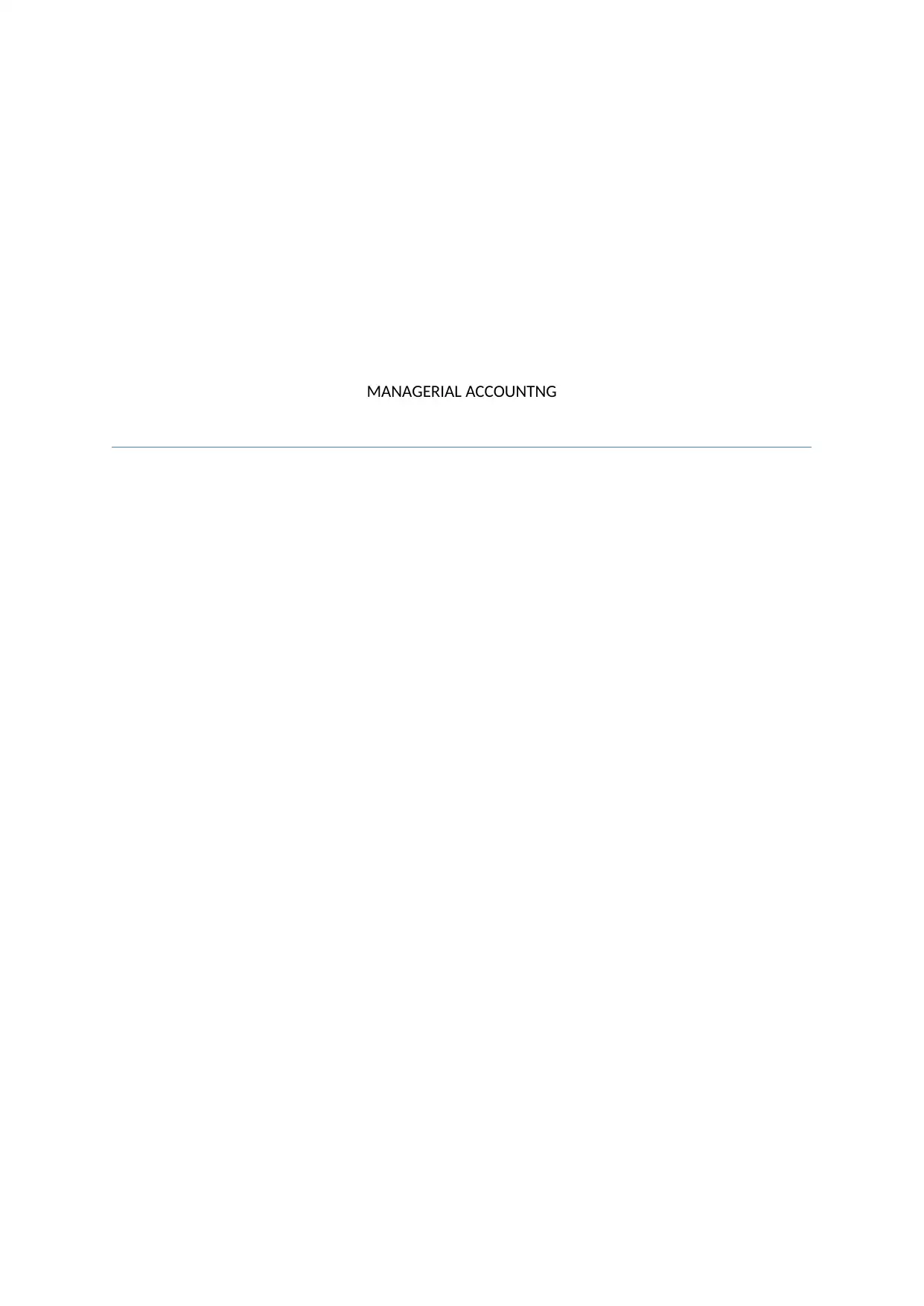
MANAGERIAL ACCOUNTNG
Paraphrase This Document
Need a fresh take? Get an instant paraphrase of this document with our AI Paraphraser
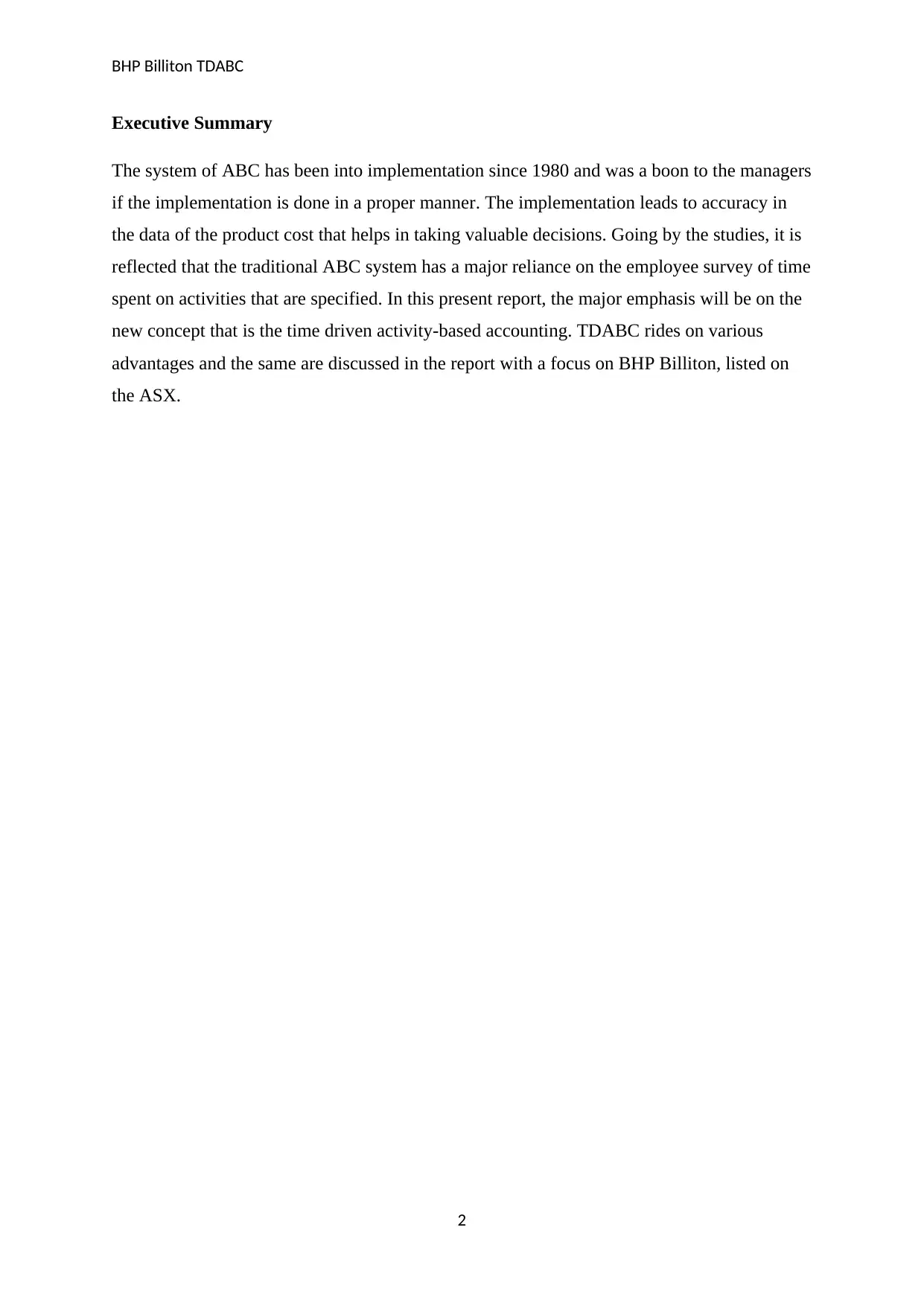
BHP Billiton TDABC
Executive Summary
The system of ABC has been into implementation since 1980 and was a boon to the managers
if the implementation is done in a proper manner. The implementation leads to accuracy in
the data of the product cost that helps in taking valuable decisions. Going by the studies, it is
reflected that the traditional ABC system has a major reliance on the employee survey of time
spent on activities that are specified. In this present report, the major emphasis will be on the
new concept that is the time driven activity-based accounting. TDABC rides on various
advantages and the same are discussed in the report with a focus on BHP Billiton, listed on
the ASX.
2
Executive Summary
The system of ABC has been into implementation since 1980 and was a boon to the managers
if the implementation is done in a proper manner. The implementation leads to accuracy in
the data of the product cost that helps in taking valuable decisions. Going by the studies, it is
reflected that the traditional ABC system has a major reliance on the employee survey of time
spent on activities that are specified. In this present report, the major emphasis will be on the
new concept that is the time driven activity-based accounting. TDABC rides on various
advantages and the same are discussed in the report with a focus on BHP Billiton, listed on
the ASX.
2
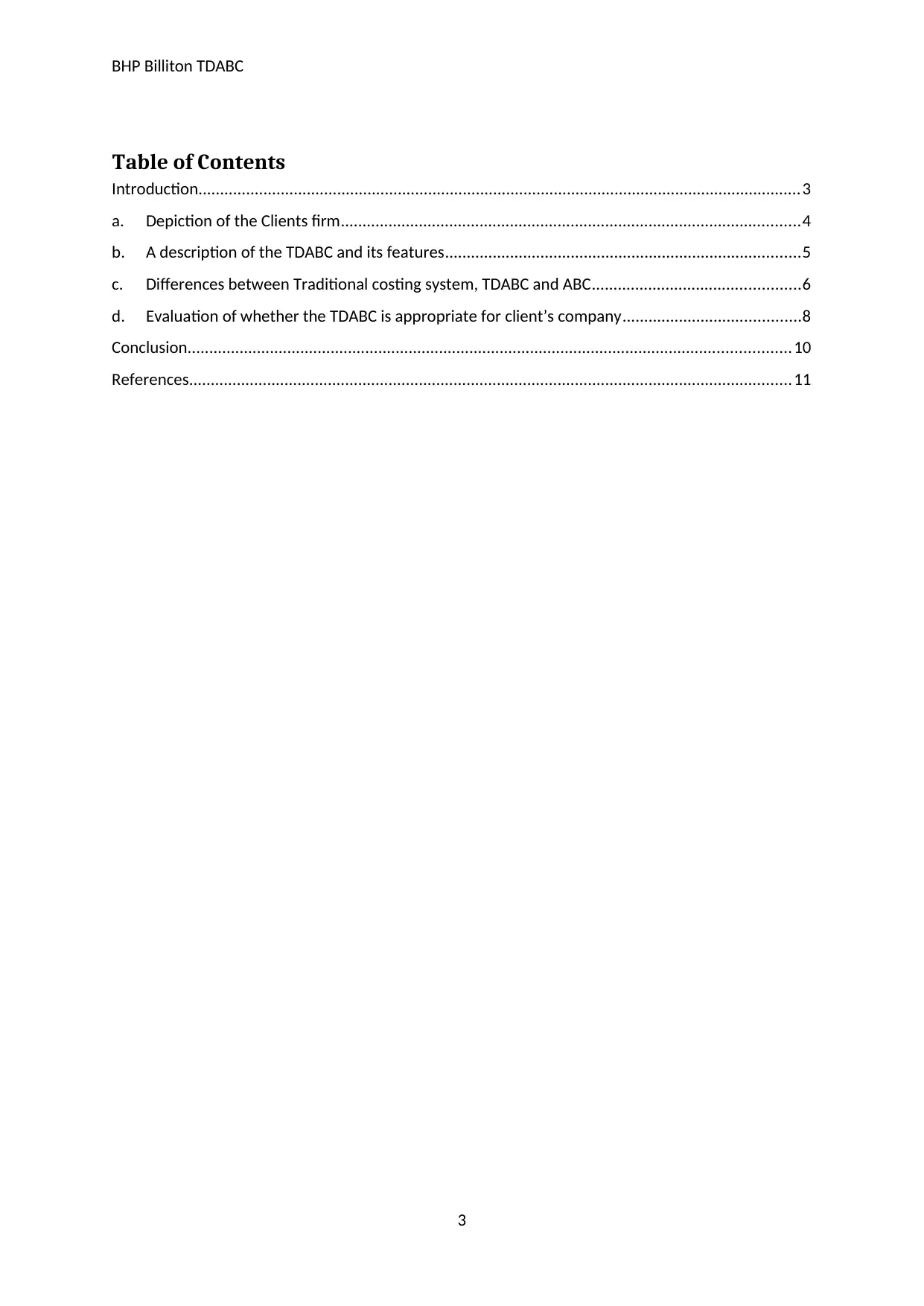
BHP Billiton TDABC
Table of Contents
Introduction...........................................................................................................................................3
a. Depiction of the Clients firm..........................................................................................................4
b. A description of the TDABC and its features..................................................................................5
c. Differences between Traditional costing system, TDABC and ABC................................................6
d. Evaluation of whether the TDABC is appropriate for client’s company.........................................8
Conclusion...........................................................................................................................................10
References...........................................................................................................................................11
3
Table of Contents
Introduction...........................................................................................................................................3
a. Depiction of the Clients firm..........................................................................................................4
b. A description of the TDABC and its features..................................................................................5
c. Differences between Traditional costing system, TDABC and ABC................................................6
d. Evaluation of whether the TDABC is appropriate for client’s company.........................................8
Conclusion...........................................................................................................................................10
References...........................................................................................................................................11
3
⊘ This is a preview!⊘
Do you want full access?
Subscribe today to unlock all pages.

Trusted by 1+ million students worldwide
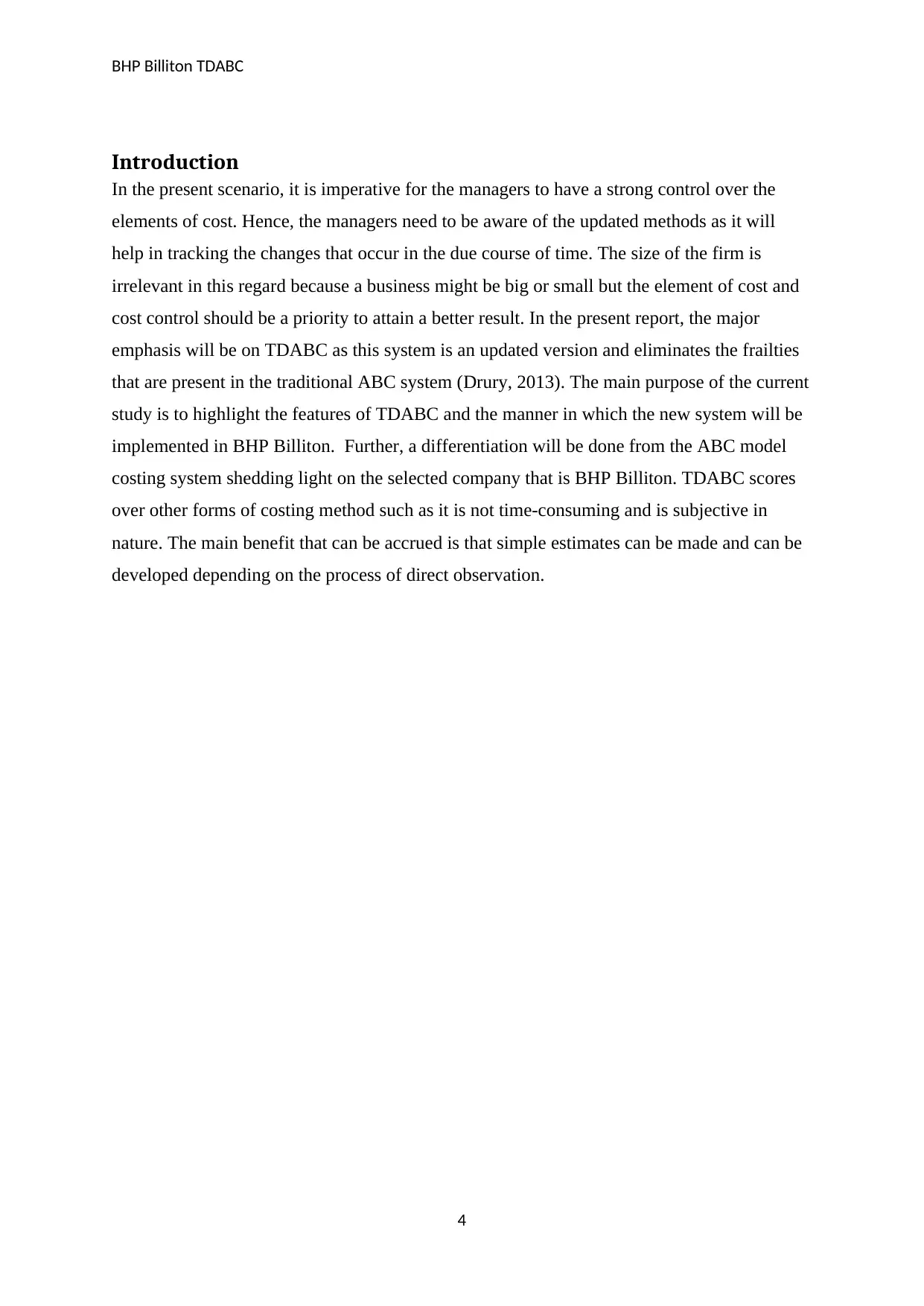
BHP Billiton TDABC
Introduction
In the present scenario, it is imperative for the managers to have a strong control over the
elements of cost. Hence, the managers need to be aware of the updated methods as it will
help in tracking the changes that occur in the due course of time. The size of the firm is
irrelevant in this regard because a business might be big or small but the element of cost and
cost control should be a priority to attain a better result. In the present report, the major
emphasis will be on TDABC as this system is an updated version and eliminates the frailties
that are present in the traditional ABC system (Drury, 2013). The main purpose of the current
study is to highlight the features of TDABC and the manner in which the new system will be
implemented in BHP Billiton. Further, a differentiation will be done from the ABC model
costing system shedding light on the selected company that is BHP Billiton. TDABC scores
over other forms of costing method such as it is not time-consuming and is subjective in
nature. The main benefit that can be accrued is that simple estimates can be made and can be
developed depending on the process of direct observation.
4
Introduction
In the present scenario, it is imperative for the managers to have a strong control over the
elements of cost. Hence, the managers need to be aware of the updated methods as it will
help in tracking the changes that occur in the due course of time. The size of the firm is
irrelevant in this regard because a business might be big or small but the element of cost and
cost control should be a priority to attain a better result. In the present report, the major
emphasis will be on TDABC as this system is an updated version and eliminates the frailties
that are present in the traditional ABC system (Drury, 2013). The main purpose of the current
study is to highlight the features of TDABC and the manner in which the new system will be
implemented in BHP Billiton. Further, a differentiation will be done from the ABC model
costing system shedding light on the selected company that is BHP Billiton. TDABC scores
over other forms of costing method such as it is not time-consuming and is subjective in
nature. The main benefit that can be accrued is that simple estimates can be made and can be
developed depending on the process of direct observation.
4
Paraphrase This Document
Need a fresh take? Get an instant paraphrase of this document with our AI Paraphraser
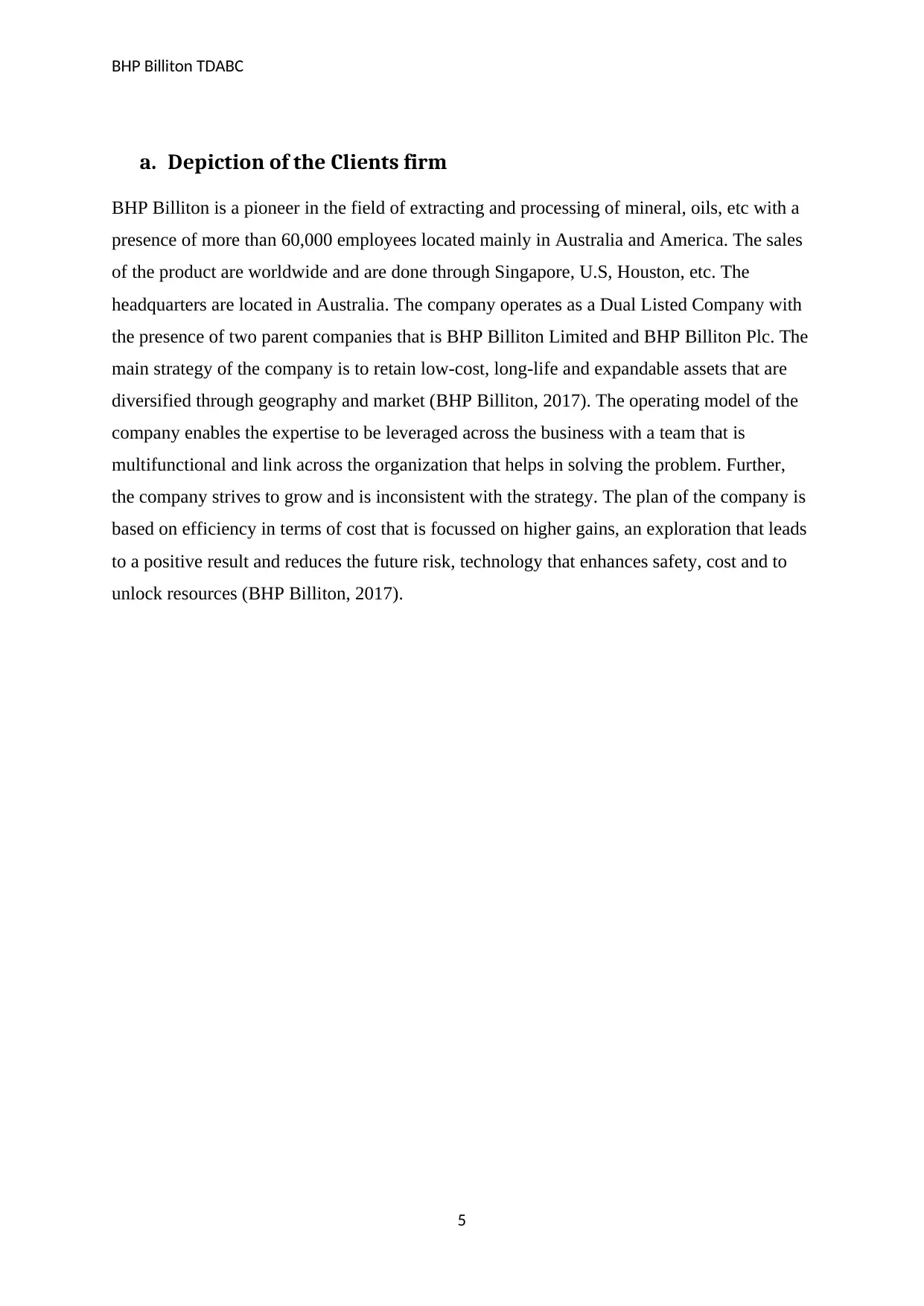
BHP Billiton TDABC
a. Depiction of the Clients firm
BHP Billiton is a pioneer in the field of extracting and processing of mineral, oils, etc with a
presence of more than 60,000 employees located mainly in Australia and America. The sales
of the product are worldwide and are done through Singapore, U.S, Houston, etc. The
headquarters are located in Australia. The company operates as a Dual Listed Company with
the presence of two parent companies that is BHP Billiton Limited and BHP Billiton Plc. The
main strategy of the company is to retain low-cost, long-life and expandable assets that are
diversified through geography and market (BHP Billiton, 2017). The operating model of the
company enables the expertise to be leveraged across the business with a team that is
multifunctional and link across the organization that helps in solving the problem. Further,
the company strives to grow and is inconsistent with the strategy. The plan of the company is
based on efficiency in terms of cost that is focussed on higher gains, an exploration that leads
to a positive result and reduces the future risk, technology that enhances safety, cost and to
unlock resources (BHP Billiton, 2017).
5
a. Depiction of the Clients firm
BHP Billiton is a pioneer in the field of extracting and processing of mineral, oils, etc with a
presence of more than 60,000 employees located mainly in Australia and America. The sales
of the product are worldwide and are done through Singapore, U.S, Houston, etc. The
headquarters are located in Australia. The company operates as a Dual Listed Company with
the presence of two parent companies that is BHP Billiton Limited and BHP Billiton Plc. The
main strategy of the company is to retain low-cost, long-life and expandable assets that are
diversified through geography and market (BHP Billiton, 2017). The operating model of the
company enables the expertise to be leveraged across the business with a team that is
multifunctional and link across the organization that helps in solving the problem. Further,
the company strives to grow and is inconsistent with the strategy. The plan of the company is
based on efficiency in terms of cost that is focussed on higher gains, an exploration that leads
to a positive result and reduces the future risk, technology that enhances safety, cost and to
unlock resources (BHP Billiton, 2017).
5
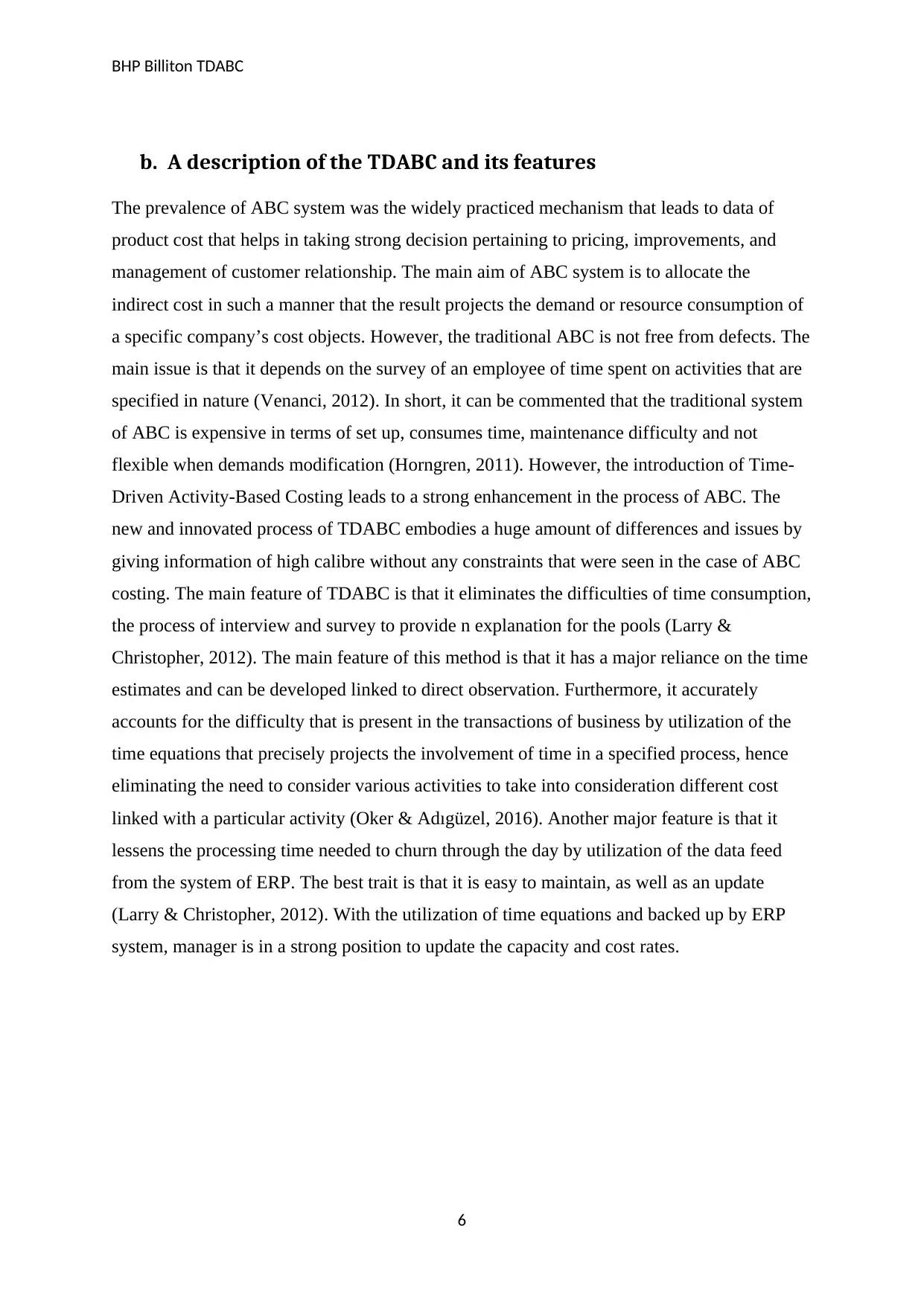
BHP Billiton TDABC
b. A description of the TDABC and its features
The prevalence of ABC system was the widely practiced mechanism that leads to data of
product cost that helps in taking strong decision pertaining to pricing, improvements, and
management of customer relationship. The main aim of ABC system is to allocate the
indirect cost in such a manner that the result projects the demand or resource consumption of
a specific company’s cost objects. However, the traditional ABC is not free from defects. The
main issue is that it depends on the survey of an employee of time spent on activities that are
specified in nature (Venanci, 2012). In short, it can be commented that the traditional system
of ABC is expensive in terms of set up, consumes time, maintenance difficulty and not
flexible when demands modification (Horngren, 2011). However, the introduction of Time-
Driven Activity-Based Costing leads to a strong enhancement in the process of ABC. The
new and innovated process of TDABC embodies a huge amount of differences and issues by
giving information of high calibre without any constraints that were seen in the case of ABC
costing. The main feature of TDABC is that it eliminates the difficulties of time consumption,
the process of interview and survey to provide n explanation for the pools (Larry &
Christopher, 2012). The main feature of this method is that it has a major reliance on the time
estimates and can be developed linked to direct observation. Furthermore, it accurately
accounts for the difficulty that is present in the transactions of business by utilization of the
time equations that precisely projects the involvement of time in a specified process, hence
eliminating the need to consider various activities to take into consideration different cost
linked with a particular activity (Oker & Adıgüzel, 2016). Another major feature is that it
lessens the processing time needed to churn through the day by utilization of the data feed
from the system of ERP. The best trait is that it is easy to maintain, as well as an update
(Larry & Christopher, 2012). With the utilization of time equations and backed up by ERP
system, manager is in a strong position to update the capacity and cost rates.
6
b. A description of the TDABC and its features
The prevalence of ABC system was the widely practiced mechanism that leads to data of
product cost that helps in taking strong decision pertaining to pricing, improvements, and
management of customer relationship. The main aim of ABC system is to allocate the
indirect cost in such a manner that the result projects the demand or resource consumption of
a specific company’s cost objects. However, the traditional ABC is not free from defects. The
main issue is that it depends on the survey of an employee of time spent on activities that are
specified in nature (Venanci, 2012). In short, it can be commented that the traditional system
of ABC is expensive in terms of set up, consumes time, maintenance difficulty and not
flexible when demands modification (Horngren, 2011). However, the introduction of Time-
Driven Activity-Based Costing leads to a strong enhancement in the process of ABC. The
new and innovated process of TDABC embodies a huge amount of differences and issues by
giving information of high calibre without any constraints that were seen in the case of ABC
costing. The main feature of TDABC is that it eliminates the difficulties of time consumption,
the process of interview and survey to provide n explanation for the pools (Larry &
Christopher, 2012). The main feature of this method is that it has a major reliance on the time
estimates and can be developed linked to direct observation. Furthermore, it accurately
accounts for the difficulty that is present in the transactions of business by utilization of the
time equations that precisely projects the involvement of time in a specified process, hence
eliminating the need to consider various activities to take into consideration different cost
linked with a particular activity (Oker & Adıgüzel, 2016). Another major feature is that it
lessens the processing time needed to churn through the day by utilization of the data feed
from the system of ERP. The best trait is that it is easy to maintain, as well as an update
(Larry & Christopher, 2012). With the utilization of time equations and backed up by ERP
system, manager is in a strong position to update the capacity and cost rates.
6
⊘ This is a preview!⊘
Do you want full access?
Subscribe today to unlock all pages.

Trusted by 1+ million students worldwide
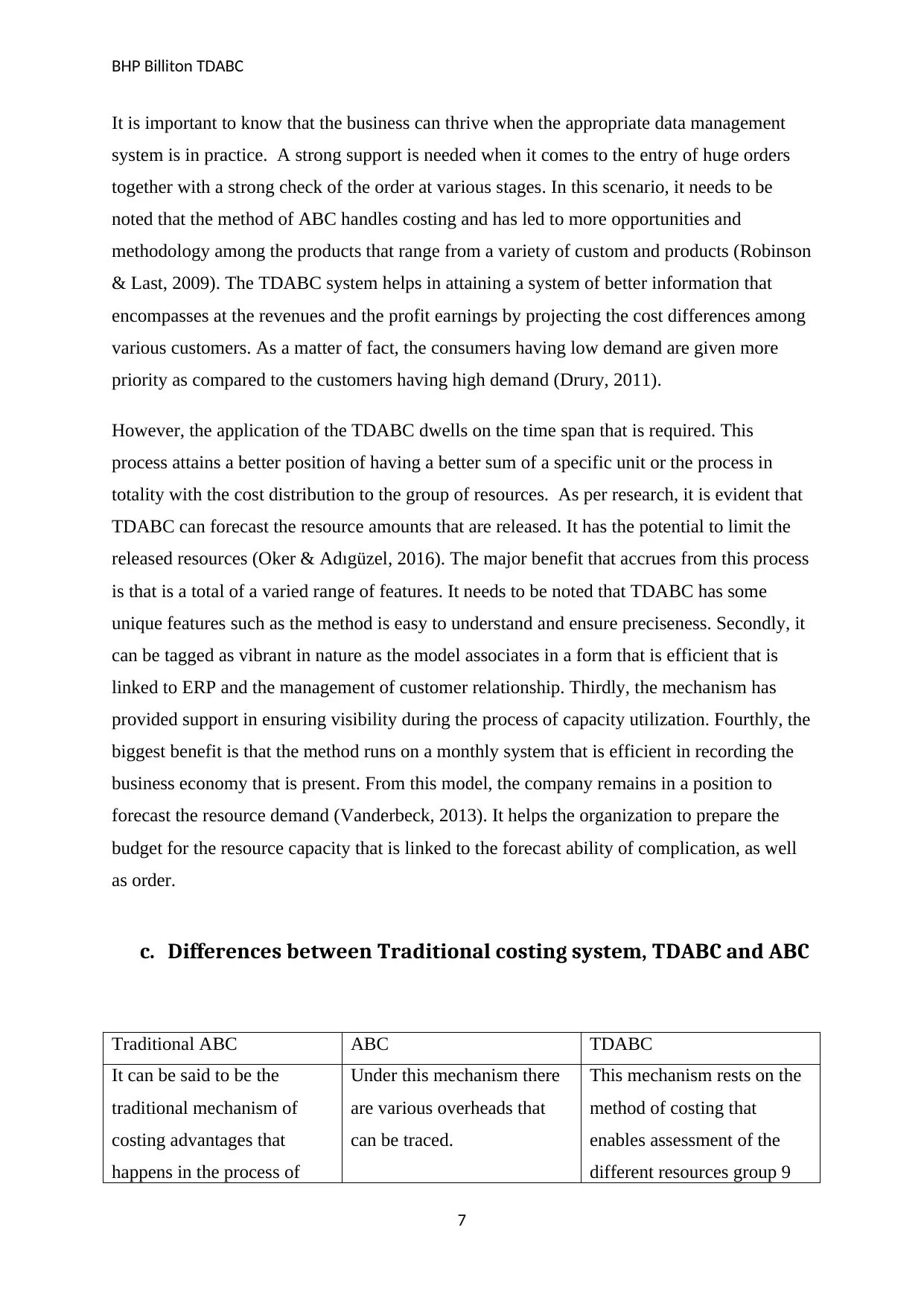
BHP Billiton TDABC
It is important to know that the business can thrive when the appropriate data management
system is in practice. A strong support is needed when it comes to the entry of huge orders
together with a strong check of the order at various stages. In this scenario, it needs to be
noted that the method of ABC handles costing and has led to more opportunities and
methodology among the products that range from a variety of custom and products (Robinson
& Last, 2009). The TDABC system helps in attaining a system of better information that
encompasses at the revenues and the profit earnings by projecting the cost differences among
various customers. As a matter of fact, the consumers having low demand are given more
priority as compared to the customers having high demand (Drury, 2011).
However, the application of the TDABC dwells on the time span that is required. This
process attains a better position of having a better sum of a specific unit or the process in
totality with the cost distribution to the group of resources. As per research, it is evident that
TDABC can forecast the resource amounts that are released. It has the potential to limit the
released resources (Oker & Adıgüzel, 2016). The major benefit that accrues from this process
is that is a total of a varied range of features. It needs to be noted that TDABC has some
unique features such as the method is easy to understand and ensure preciseness. Secondly, it
can be tagged as vibrant in nature as the model associates in a form that is efficient that is
linked to ERP and the management of customer relationship. Thirdly, the mechanism has
provided support in ensuring visibility during the process of capacity utilization. Fourthly, the
biggest benefit is that the method runs on a monthly system that is efficient in recording the
business economy that is present. From this model, the company remains in a position to
forecast the resource demand (Vanderbeck, 2013). It helps the organization to prepare the
budget for the resource capacity that is linked to the forecast ability of complication, as well
as order.
c. Differences between Traditional costing system, TDABC and ABC
Traditional ABC ABC TDABC
It can be said to be the
traditional mechanism of
costing advantages that
happens in the process of
Under this mechanism there
are various overheads that
can be traced.
This mechanism rests on the
method of costing that
enables assessment of the
different resources group 9
7
It is important to know that the business can thrive when the appropriate data management
system is in practice. A strong support is needed when it comes to the entry of huge orders
together with a strong check of the order at various stages. In this scenario, it needs to be
noted that the method of ABC handles costing and has led to more opportunities and
methodology among the products that range from a variety of custom and products (Robinson
& Last, 2009). The TDABC system helps in attaining a system of better information that
encompasses at the revenues and the profit earnings by projecting the cost differences among
various customers. As a matter of fact, the consumers having low demand are given more
priority as compared to the customers having high demand (Drury, 2011).
However, the application of the TDABC dwells on the time span that is required. This
process attains a better position of having a better sum of a specific unit or the process in
totality with the cost distribution to the group of resources. As per research, it is evident that
TDABC can forecast the resource amounts that are released. It has the potential to limit the
released resources (Oker & Adıgüzel, 2016). The major benefit that accrues from this process
is that is a total of a varied range of features. It needs to be noted that TDABC has some
unique features such as the method is easy to understand and ensure preciseness. Secondly, it
can be tagged as vibrant in nature as the model associates in a form that is efficient that is
linked to ERP and the management of customer relationship. Thirdly, the mechanism has
provided support in ensuring visibility during the process of capacity utilization. Fourthly, the
biggest benefit is that the method runs on a monthly system that is efficient in recording the
business economy that is present. From this model, the company remains in a position to
forecast the resource demand (Vanderbeck, 2013). It helps the organization to prepare the
budget for the resource capacity that is linked to the forecast ability of complication, as well
as order.
c. Differences between Traditional costing system, TDABC and ABC
Traditional ABC ABC TDABC
It can be said to be the
traditional mechanism of
costing advantages that
happens in the process of
Under this mechanism there
are various overheads that
can be traced.
This mechanism rests on the
method of costing that
enables assessment of the
different resources group 9
7
Paraphrase This Document
Need a fresh take? Get an instant paraphrase of this document with our AI Paraphraser
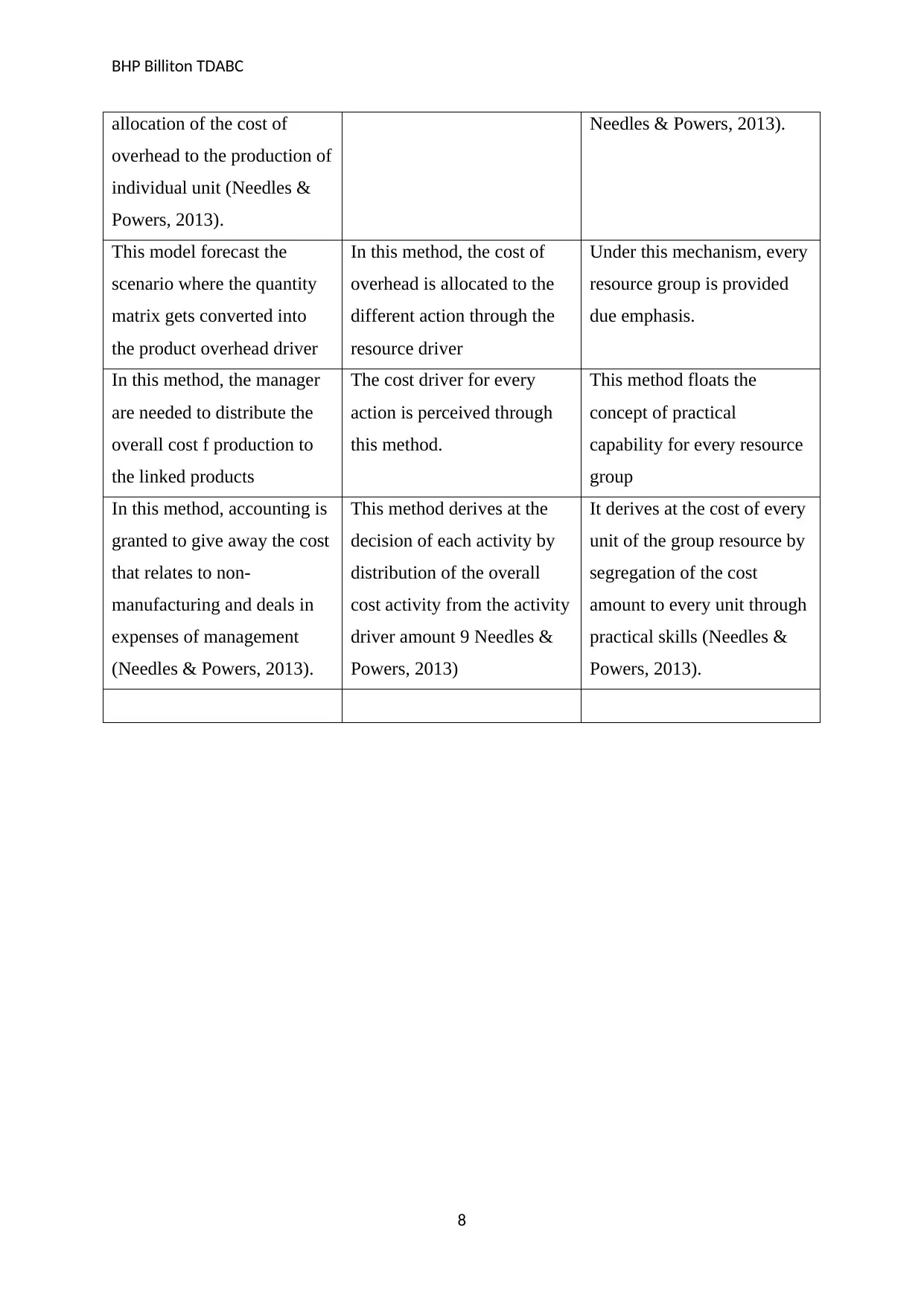
BHP Billiton TDABC
allocation of the cost of
overhead to the production of
individual unit (Needles &
Powers, 2013).
Needles & Powers, 2013).
This model forecast the
scenario where the quantity
matrix gets converted into
the product overhead driver
In this method, the cost of
overhead is allocated to the
different action through the
resource driver
Under this mechanism, every
resource group is provided
due emphasis.
In this method, the manager
are needed to distribute the
overall cost f production to
the linked products
The cost driver for every
action is perceived through
this method.
This method floats the
concept of practical
capability for every resource
group
In this method, accounting is
granted to give away the cost
that relates to non-
manufacturing and deals in
expenses of management
(Needles & Powers, 2013).
This method derives at the
decision of each activity by
distribution of the overall
cost activity from the activity
driver amount 9 Needles &
Powers, 2013)
It derives at the cost of every
unit of the group resource by
segregation of the cost
amount to every unit through
practical skills (Needles &
Powers, 2013).
8
allocation of the cost of
overhead to the production of
individual unit (Needles &
Powers, 2013).
Needles & Powers, 2013).
This model forecast the
scenario where the quantity
matrix gets converted into
the product overhead driver
In this method, the cost of
overhead is allocated to the
different action through the
resource driver
Under this mechanism, every
resource group is provided
due emphasis.
In this method, the manager
are needed to distribute the
overall cost f production to
the linked products
The cost driver for every
action is perceived through
this method.
This method floats the
concept of practical
capability for every resource
group
In this method, accounting is
granted to give away the cost
that relates to non-
manufacturing and deals in
expenses of management
(Needles & Powers, 2013).
This method derives at the
decision of each activity by
distribution of the overall
cost activity from the activity
driver amount 9 Needles &
Powers, 2013)
It derives at the cost of every
unit of the group resource by
segregation of the cost
amount to every unit through
practical skills (Needles &
Powers, 2013).
8
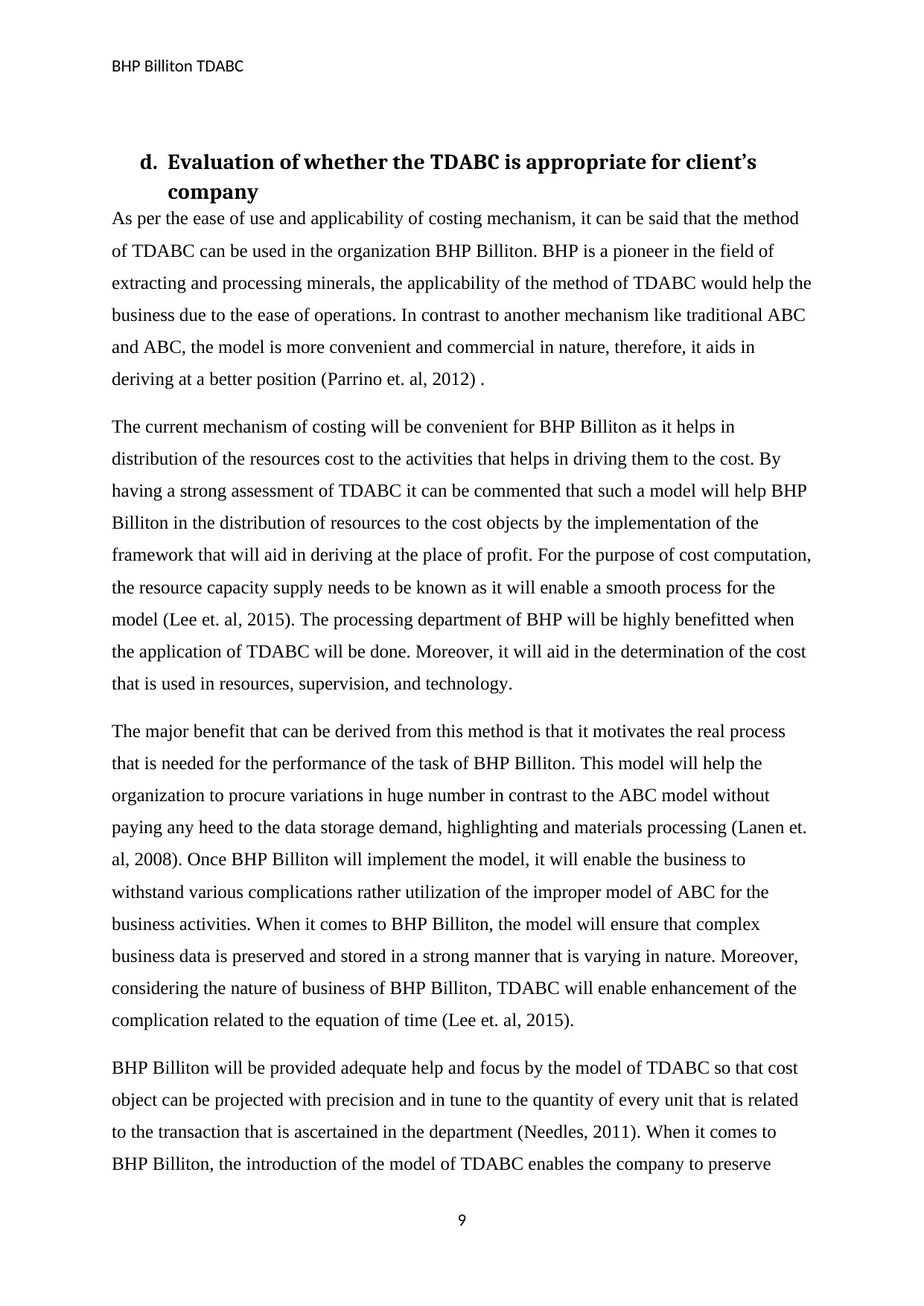
BHP Billiton TDABC
d. Evaluation of whether the TDABC is appropriate for client’s
company
As per the ease of use and applicability of costing mechanism, it can be said that the method
of TDABC can be used in the organization BHP Billiton. BHP is a pioneer in the field of
extracting and processing minerals, the applicability of the method of TDABC would help the
business due to the ease of operations. In contrast to another mechanism like traditional ABC
and ABC, the model is more convenient and commercial in nature, therefore, it aids in
deriving at a better position (Parrino et. al, 2012) .
The current mechanism of costing will be convenient for BHP Billiton as it helps in
distribution of the resources cost to the activities that helps in driving them to the cost. By
having a strong assessment of TDABC it can be commented that such a model will help BHP
Billiton in the distribution of resources to the cost objects by the implementation of the
framework that will aid in deriving at the place of profit. For the purpose of cost computation,
the resource capacity supply needs to be known as it will enable a smooth process for the
model (Lee et. al, 2015). The processing department of BHP will be highly benefitted when
the application of TDABC will be done. Moreover, it will aid in the determination of the cost
that is used in resources, supervision, and technology.
The major benefit that can be derived from this method is that it motivates the real process
that is needed for the performance of the task of BHP Billiton. This model will help the
organization to procure variations in huge number in contrast to the ABC model without
paying any heed to the data storage demand, highlighting and materials processing (Lanen et.
al, 2008). Once BHP Billiton will implement the model, it will enable the business to
withstand various complications rather utilization of the improper model of ABC for the
business activities. When it comes to BHP Billiton, the model will ensure that complex
business data is preserved and stored in a strong manner that is varying in nature. Moreover,
considering the nature of business of BHP Billiton, TDABC will enable enhancement of the
complication related to the equation of time (Lee et. al, 2015).
BHP Billiton will be provided adequate help and focus by the model of TDABC so that cost
object can be projected with precision and in tune to the quantity of every unit that is related
to the transaction that is ascertained in the department (Needles, 2011). When it comes to
BHP Billiton, the introduction of the model of TDABC enables the company to preserve
9
d. Evaluation of whether the TDABC is appropriate for client’s
company
As per the ease of use and applicability of costing mechanism, it can be said that the method
of TDABC can be used in the organization BHP Billiton. BHP is a pioneer in the field of
extracting and processing minerals, the applicability of the method of TDABC would help the
business due to the ease of operations. In contrast to another mechanism like traditional ABC
and ABC, the model is more convenient and commercial in nature, therefore, it aids in
deriving at a better position (Parrino et. al, 2012) .
The current mechanism of costing will be convenient for BHP Billiton as it helps in
distribution of the resources cost to the activities that helps in driving them to the cost. By
having a strong assessment of TDABC it can be commented that such a model will help BHP
Billiton in the distribution of resources to the cost objects by the implementation of the
framework that will aid in deriving at the place of profit. For the purpose of cost computation,
the resource capacity supply needs to be known as it will enable a smooth process for the
model (Lee et. al, 2015). The processing department of BHP will be highly benefitted when
the application of TDABC will be done. Moreover, it will aid in the determination of the cost
that is used in resources, supervision, and technology.
The major benefit that can be derived from this method is that it motivates the real process
that is needed for the performance of the task of BHP Billiton. This model will help the
organization to procure variations in huge number in contrast to the ABC model without
paying any heed to the data storage demand, highlighting and materials processing (Lanen et.
al, 2008). Once BHP Billiton will implement the model, it will enable the business to
withstand various complications rather utilization of the improper model of ABC for the
business activities. When it comes to BHP Billiton, the model will ensure that complex
business data is preserved and stored in a strong manner that is varying in nature. Moreover,
considering the nature of business of BHP Billiton, TDABC will enable enhancement of the
complication related to the equation of time (Lee et. al, 2015).
BHP Billiton will be provided adequate help and focus by the model of TDABC so that cost
object can be projected with precision and in tune to the quantity of every unit that is related
to the transaction that is ascertained in the department (Needles, 2011). When it comes to
BHP Billiton, the introduction of the model of TDABC enables the company to preserve
9
⊘ This is a preview!⊘
Do you want full access?
Subscribe today to unlock all pages.

Trusted by 1+ million students worldwide
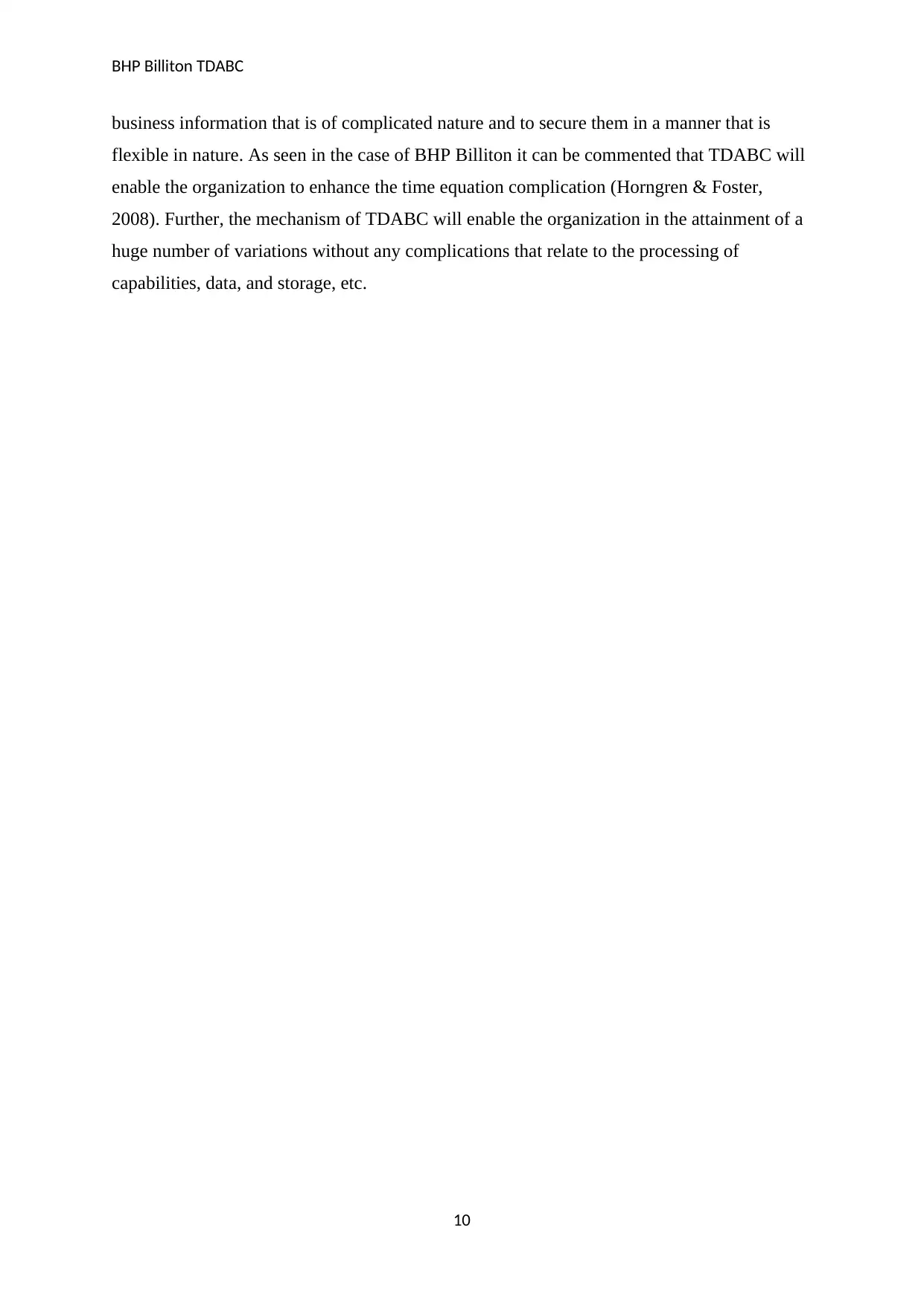
BHP Billiton TDABC
business information that is of complicated nature and to secure them in a manner that is
flexible in nature. As seen in the case of BHP Billiton it can be commented that TDABC will
enable the organization to enhance the time equation complication (Horngren & Foster,
2008). Further, the mechanism of TDABC will enable the organization in the attainment of a
huge number of variations without any complications that relate to the processing of
capabilities, data, and storage, etc.
10
business information that is of complicated nature and to secure them in a manner that is
flexible in nature. As seen in the case of BHP Billiton it can be commented that TDABC will
enable the organization to enhance the time equation complication (Horngren & Foster,
2008). Further, the mechanism of TDABC will enable the organization in the attainment of a
huge number of variations without any complications that relate to the processing of
capabilities, data, and storage, etc.
10
Paraphrase This Document
Need a fresh take? Get an instant paraphrase of this document with our AI Paraphraser
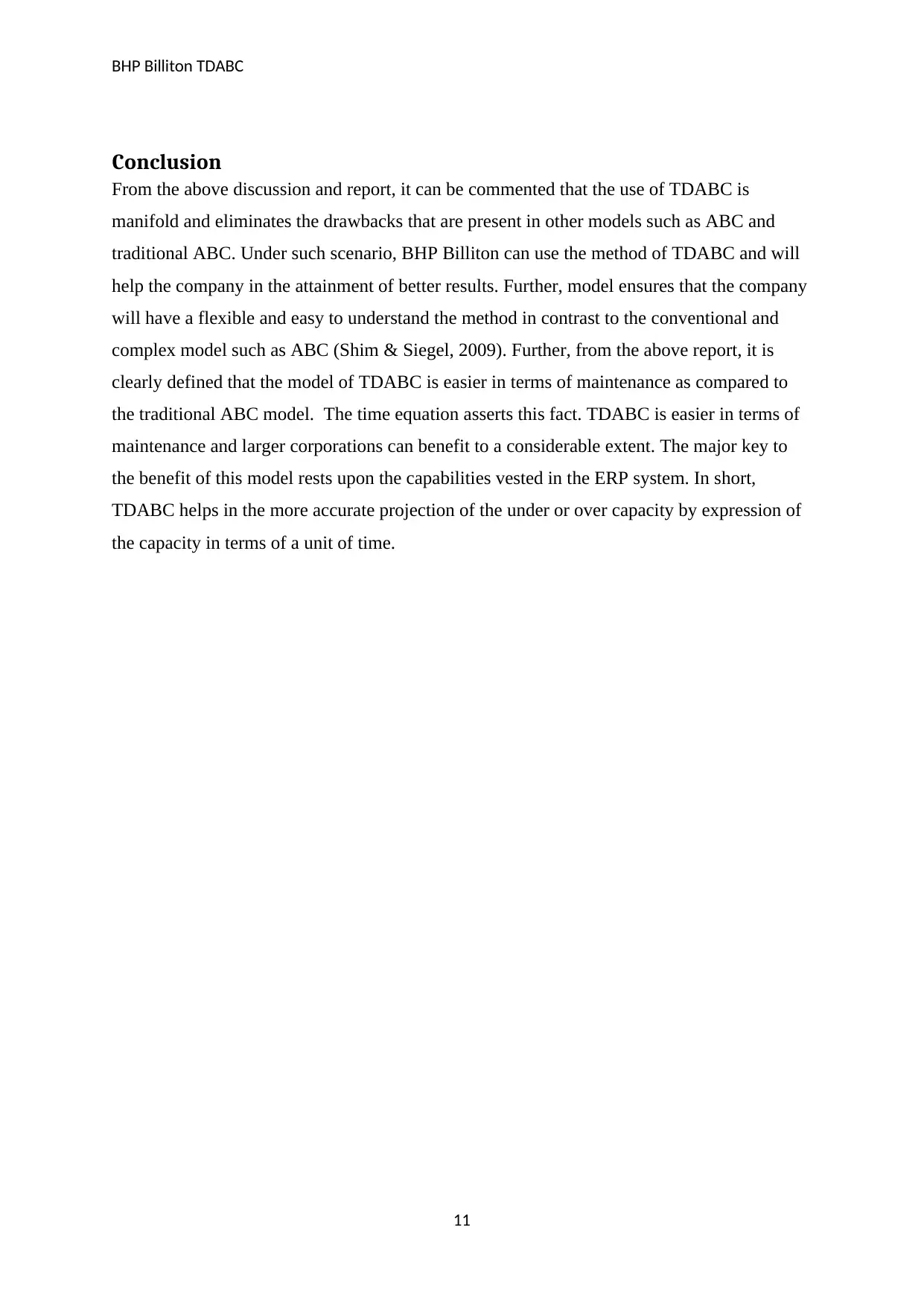
BHP Billiton TDABC
Conclusion
From the above discussion and report, it can be commented that the use of TDABC is
manifold and eliminates the drawbacks that are present in other models such as ABC and
traditional ABC. Under such scenario, BHP Billiton can use the method of TDABC and will
help the company in the attainment of better results. Further, model ensures that the company
will have a flexible and easy to understand the method in contrast to the conventional and
complex model such as ABC (Shim & Siegel, 2009). Further, from the above report, it is
clearly defined that the model of TDABC is easier in terms of maintenance as compared to
the traditional ABC model. The time equation asserts this fact. TDABC is easier in terms of
maintenance and larger corporations can benefit to a considerable extent. The major key to
the benefit of this model rests upon the capabilities vested in the ERP system. In short,
TDABC helps in the more accurate projection of the under or over capacity by expression of
the capacity in terms of a unit of time.
11
Conclusion
From the above discussion and report, it can be commented that the use of TDABC is
manifold and eliminates the drawbacks that are present in other models such as ABC and
traditional ABC. Under such scenario, BHP Billiton can use the method of TDABC and will
help the company in the attainment of better results. Further, model ensures that the company
will have a flexible and easy to understand the method in contrast to the conventional and
complex model such as ABC (Shim & Siegel, 2009). Further, from the above report, it is
clearly defined that the model of TDABC is easier in terms of maintenance as compared to
the traditional ABC model. The time equation asserts this fact. TDABC is easier in terms of
maintenance and larger corporations can benefit to a considerable extent. The major key to
the benefit of this model rests upon the capabilities vested in the ERP system. In short,
TDABC helps in the more accurate projection of the under or over capacity by expression of
the capacity in terms of a unit of time.
11
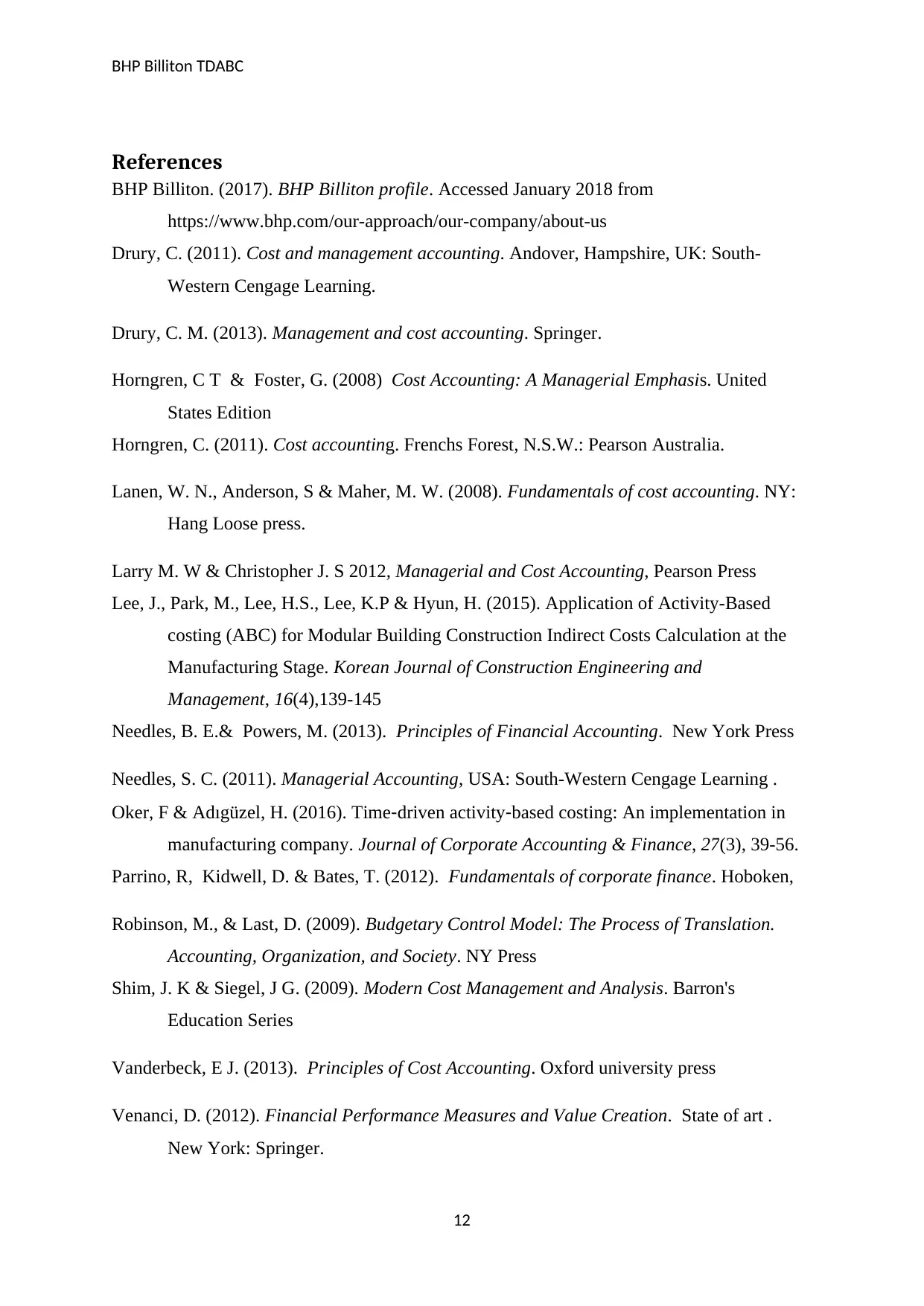
BHP Billiton TDABC
References
BHP Billiton. (2017). BHP Billiton profile. Accessed January 2018 from
https://www.bhp.com/our-approach/our-company/about-us
Drury, C. (2011). Cost and management accounting. Andover, Hampshire, UK: South-
Western Cengage Learning.
Drury, C. M. (2013). Management and cost accounting. Springer.
Horngren, C T & Foster, G. (2008) Cost Accounting: A Managerial Emphasis. United
States Edition
Horngren, C. (2011). Cost accounting. Frenchs Forest, N.S.W.: Pearson Australia.
Lanen, W. N., Anderson, S & Maher, M. W. (2008). Fundamentals of cost accounting. NY:
Hang Loose press.
Larry M. W & Christopher J. S 2012, Managerial and Cost Accounting, Pearson Press
Lee, J., Park, M., Lee, H.S., Lee, K.P & Hyun, H. (2015). Application of Activity-Based
costing (ABC) for Modular Building Construction Indirect Costs Calculation at the
Manufacturing Stage. Korean Journal of Construction Engineering and
Management, 16(4),139-145
Needles, B. E.& Powers, M. (2013). Principles of Financial Accounting. New York Press
Needles, S. C. (2011). Managerial Accounting, USA: South-Western Cengage Learning .
Oker, F & Adıgüzel, H. (2016). Time‐driven activity‐based costing: An implementation in
manufacturing company. Journal of Corporate Accounting & Finance, 27(3), 39-56.
Parrino, R, Kidwell, D. & Bates, T. (2012). Fundamentals of corporate finance. Hoboken,
Robinson, M., & Last, D. (2009). Budgetary Control Model: The Process of Translation.
Accounting, Organization, and Society. NY Press
Shim, J. K & Siegel, J G. (2009). Modern Cost Management and Analysis. Barron's
Education Series
Vanderbeck, E J. (2013). Principles of Cost Accounting. Oxford university press
Venanci, D. (2012). Financial Performance Measures and Value Creation. State of art .
New York: Springer.
12
References
BHP Billiton. (2017). BHP Billiton profile. Accessed January 2018 from
https://www.bhp.com/our-approach/our-company/about-us
Drury, C. (2011). Cost and management accounting. Andover, Hampshire, UK: South-
Western Cengage Learning.
Drury, C. M. (2013). Management and cost accounting. Springer.
Horngren, C T & Foster, G. (2008) Cost Accounting: A Managerial Emphasis. United
States Edition
Horngren, C. (2011). Cost accounting. Frenchs Forest, N.S.W.: Pearson Australia.
Lanen, W. N., Anderson, S & Maher, M. W. (2008). Fundamentals of cost accounting. NY:
Hang Loose press.
Larry M. W & Christopher J. S 2012, Managerial and Cost Accounting, Pearson Press
Lee, J., Park, M., Lee, H.S., Lee, K.P & Hyun, H. (2015). Application of Activity-Based
costing (ABC) for Modular Building Construction Indirect Costs Calculation at the
Manufacturing Stage. Korean Journal of Construction Engineering and
Management, 16(4),139-145
Needles, B. E.& Powers, M. (2013). Principles of Financial Accounting. New York Press
Needles, S. C. (2011). Managerial Accounting, USA: South-Western Cengage Learning .
Oker, F & Adıgüzel, H. (2016). Time‐driven activity‐based costing: An implementation in
manufacturing company. Journal of Corporate Accounting & Finance, 27(3), 39-56.
Parrino, R, Kidwell, D. & Bates, T. (2012). Fundamentals of corporate finance. Hoboken,
Robinson, M., & Last, D. (2009). Budgetary Control Model: The Process of Translation.
Accounting, Organization, and Society. NY Press
Shim, J. K & Siegel, J G. (2009). Modern Cost Management and Analysis. Barron's
Education Series
Vanderbeck, E J. (2013). Principles of Cost Accounting. Oxford university press
Venanci, D. (2012). Financial Performance Measures and Value Creation. State of art .
New York: Springer.
12
⊘ This is a preview!⊘
Do you want full access?
Subscribe today to unlock all pages.

Trusted by 1+ million students worldwide
1 out of 12
Related Documents
Your All-in-One AI-Powered Toolkit for Academic Success.
+13062052269
info@desklib.com
Available 24*7 on WhatsApp / Email
![[object Object]](/_next/static/media/star-bottom.7253800d.svg)
Unlock your academic potential
Copyright © 2020–2025 A2Z Services. All Rights Reserved. Developed and managed by ZUCOL.





